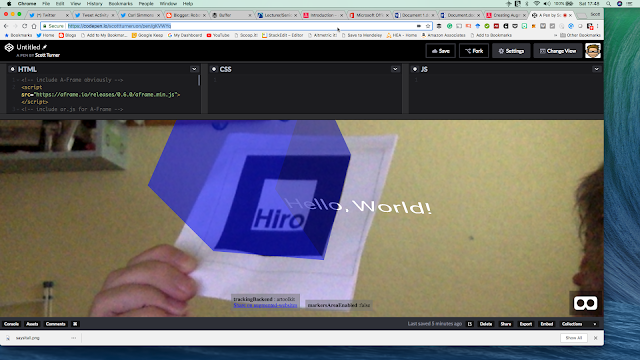Introduction
This is part of a short series of articles about some experiments with WebVR Web-based Virtual Reality - in this case based on the wonderful A-Frame (https://aframe.io) . In the first post WebVR playtime 1: Basics of setting up, images and rotating blocks, I looked at setting up a scene and then rotating an object. In the second post, recapped the basics, then look at adding video, 360 degree video, and models developed elsewhere.
In this post we are going to start looking at using WebVR as part of an augmented reality solution. I going to start by building on the great resource Creating Augmented Reality with AR.js and A-Frame by Jerome Etienne, creator of AR.js - the starting code below and the basis of the solution comes from that resource.
Getting started.
In the previous two posts I used Thimble from Mozilla, I had a problem with access my camera using Thimble so I switched to Glitch - you may need to register - and Codepen.io.
The code below was adapted from the Creating Augmented Reality with AR.js and A-Frame page.
<!-- include A-Frame obviously -->
<script src="https://aframe.io/releases/0.6.0/aframe.min.js"></script>
<!-- include ar.js for A-Frame -->
<script src="https://jeromeetienne.github.io/AR.js/aframe/build/aframe-ar.js"></script>
<body style="margin : 0px; overflow: hidden;">
<a-scene embedded arjs>
<!-- create your content here. -->
<!-- define a camera which will move according to the marker position -->
<a-marker-camera preset="hiro"></a-marker-camera>
</a-scene>
</body>
The first script line is the same as in the previous posts setting up the A-Frame WebVR. The second one adds the additional functionality for Augmented Reality via markers. The only other new feature is within the <a-scene></a-scene> tags, a new set of tags <a-marker-camera> saying which markers is being used; in this case, a preset one called Hiro (see below), which available in AR.js.
A blue box and text were added to the scene - just in the same way as adding boxes and text in the first of this series. Shown in code pen below
Using the Hiro marker go to https://codepen.io/scottturneruon/pen/gKVWYq to play!
Next Step
To take this forward I wanted to replace the text and box with some rotating text when the marker is visible. On the AR in action can be found at http://bit.ly/2N0nvWx; you will need the Hiro marker.
The code for the AR in action is shown below.
<script src="https://jeromeetienne.github.io/AR.js/aframe/build/aframe-ar.js"></script>
<body style="margin : 0px; overflow: hidden;">
<a-scene embedded arjs>
<!-- create your content here. just a box for now -->
<a-text value="University of" color="blue" position="0 0.5 -0.5" align="center" height="2"><a-animation attribute="rotation" dur="5000" to="360 0 0" direction="alternate" repeat="indefinite"></a-animation>
</a-text>
<a-text value="Northampton" color="blue" position="0 0.325 0" height="3" align="center"><a-animation attribute="rotation" dur="5000" to="360 0 0" direction="alternate" repeat="indefinite"></a-animation>
</a-text>
<!-- define a camera which will move according to the marker position -->
<a-marker-camera preset="hiro"></a-marker-camera>
</a-scene>
</body>
Where next
Adding images to objects and adding models are the next experiments.
To read more go to
- https://aframe.io/docs/0.7.0/introduction/
- Creating Augmented Reality with AR.js and A-Frame by Jerome Etienne
- WebVR playtime 1: Basics of setting up, images and rotating blocks
- http://robotsandphysicalcomputing.blogspot.com/2018/02/webvr-playtime-2-video-360-video-and.html
All opinions in this blog are the Author's and should not in any way be seen as reflecting the views of any organisation the Author has any association with. Twitter @scottturneruon







